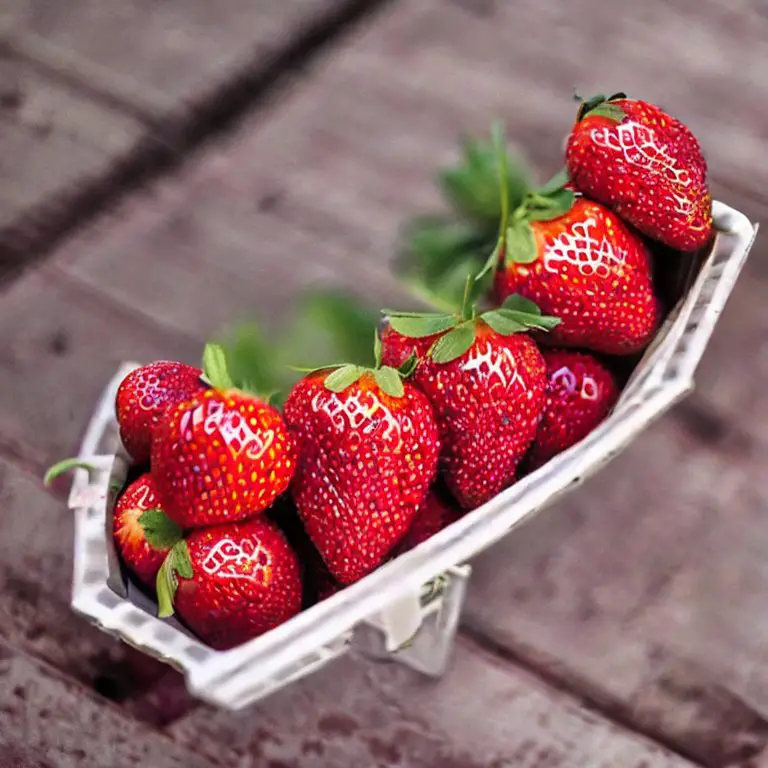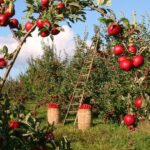
In this post, we will look at common fruits that start with the letter S (in English).
We will look at a list of the most popular fruits first, and then each fruit that begins with the letter S in more depth further down. (You may also be interested in Berries that Start with S)
Contents
- Popular Fruits that Start with S
- List of Fruits that Start with S
- Fruits that Start with the Letter S
- Other Lists of Fruits
Popular Fruits that Start with S
There are many fruits that start with the letter “S”. Some examples include:
- Strawberries: Strawberries are small, red, juicy fruits that are known for their sweet flavor and delicate, fragrant aroma. They are often eaten fresh, sliced and served with cream or sugar, or used in a variety of dishes such as pies, jams, and smoothies.
- Starfruit: also known as carambola, this fruit is native to Southeast Asia and is known for its star-shaped cross-section. It has a sweet, slightly sour flavor and is often eaten fresh or used in salads, desserts, and other dishes.
- Sapodilla: also known as chikoo, this fruit is native to Central America and is known for its brown, scaly skin and soft, sweet flesh. It has a rich, caramel-like flavor and is often eaten fresh or used in smoothies and other dishes.
- Sweet Cherries: also known as Bing cherries, these are plump, juicy fruits with a deep red color and a sweet, slightly tart flavor. They are often eaten fresh or used in pies, jams, and other desserts.
- Sour Cherries: also known as tart cherries, these are smaller and more acidic than sweet cherries. They are often used in cooking, as their tart flavor is perfect for adding depth to savory dishes.
List of Fruits that Start with S
Here is a list of fruits that start with the letter “S”:
- Strawberries
- Starfruit
- Sapodilla
- Sweet Cherries
- Sour Cherries
- Snake Fruit
- Soursop
- Spanish Lime
- Star Apple
- Sugar-Apple
- Serviceberry
- Sea Grape
- Satuma
- Santa Claus Melon
- Salmonberry
- Sugarplum
- Snowberry
- Shipova
- Sloe
- Spanish Cherry
- Surinam Cherry
- Strawberry Guava
- Sultana
- Spicebush
- Swirl Melon
Fruits that Start with the Letter S
Strawberries
Strawberries are small, red, juicy fruits that are known for their sweet flavor and delicate, fragrant aroma. They are often eaten fresh, sliced and served with cream or sugar, or used in a variety of dishes such as pies, jams, and smoothies.
Strawberries are a member of the rose family, and are closely related to other fruits such as raspberries and blackberries. They have a small, seed-covered surface and a soft, juicy flesh. The flavor of strawberries is sweet and slightly tangy, with a delicate aroma that is often used to flavor a variety of foods and beverages.

Strawberries are a good source of vitamins C and K, as well as important minerals such as potassium and magnesium. They are also low in calories and high in fiber, making them a healthy choice for those looking to maintain a balanced diet.
Strawberries are typically available in the spring and summer, and can be found at most grocery stores or markets that sell fresh produce. They are also easy to grow and are often included in home gardens.
Starfruit
Starfruit, also known as carambola, is a tropical fruit that is native to Southeast Asia. It is shaped like a star when sliced, which is where it gets its name. Starfruit has a sweet, tangy flavor and a crisp, crunchy texture. It is often eaten fresh as a snack, or used in salads, smoothies, and other dishes.
Starfruit is a good source of vitamins and minerals, including vitamin C, vitamin B, and potassium. It is also high in antioxidants, which can help protect against diseases like cancer and heart disease. Starfruit is often used in cooking and baking, and can be added to a variety of dishes for a burst of flavor.
Starfruit is most commonly used in desserts and other sweet dishes, but it can also be used in savory recipes. It is often added to salads, smoothies, and other drinks, and can be used in cakes, cookies, and other baked goods for a sweet, tangy flavor. Starfruit is also sometimes used in savory dishes, like sauces, soups, and stews.
In addition to its culinary uses, starfruit is also sometimes used for its medicinal properties. It is believed to have anti-inflammatory and antiviral properties, and has been used to treat a variety of conditions, including colds, flu, and sore throats. Starfruit is also a good source of fiber, which can help support healthy digestion and prevent constipation.
Sapodilla
Sapodilla, also known as chikoo or sapota, is a tropical fruit native to Central America. It is known for its brown, scaly skin and soft, sweet flesh.
Sapodilla is oval or round in shape, with a rough, scaly skin that is brown when ripe. The flesh of the fruit is soft and juicy, with a rich, caramel-like flavor. The seeds of the fruit are small and edible, but are often discarded due to their hard texture.
Sapodilla is a good source of vitamins C and A, as well as important minerals such as potassium and magnesium.
Sweet Cherries
Sweet Cherries, also known as Bing cherries, are plump, juicy fruits with a deep red color and a sweet, slightly tart flavor. They are often eaten fresh or used in pies, jams, and other desserts.
Sweet Cherries are a type of stone fruit, and are closely related to other fruits such as plums and peaches. They have a smooth, glossy skin and a firm, juicy flesh. The flavor of sweet cherries is sweet and slightly tart, with a delicate aroma that is often used to flavor a variety of foods and beverages.
Sweet Cherries are a good source of vitamins A and C, as well as important minerals such as potassium and magnesium.
Sweet Cherries are typically available in the summer, and can be found at most grocery stores or markets that sell fresh produce. They are also easy to grow and are often included in home gardens.
Sour Cherries
Sour Cherries, also known as tart cherries, are small, acidic fruits that are often used in cooking. They are known for their bright red color and tangy, tart flavor.
Sour Cherries are a type of stone fruit, and are closely related to other fruits such as sweet cherries and plums. They have a smooth, glossy skin and a firm, juicy flesh. The flavor of sour cherries is tangy and tart, with a slightly astringent quality that makes them perfect for cooking and baking.
Snake Fruit
Snake fruit, also known as salak, is a tropical fruit native to Indonesia and other parts of Southeast Asia. It is known for its unique, scaly skin and sweet, slightly acidic flavor.
Snake fruit is oval or oblong in shape, with a thin, scaly skin that is brown when ripe. The flesh of the fruit is juicy and crisp, with a sweet, slightly acidic flavor. The seeds of the fruit are small and edible, but are often discarded due to their hard texture.
Snake fruit is typically available in the summer and fall.
Soursop
Soursop, also known as graviola or guanabana, is a tropical fruit native to Central and South America. It is known for its spiky, green skin and soft, white flesh.
Soursop is oblong or oval in shape, with a rough, spiky skin that is green when ripe. The flesh of the fruit is soft and juicy, with a sweet, slightly acidic flavor. The seeds of the fruit are large and inedible, and are often discarded.
Soursop is a good source of vitamins C and B, as well as important minerals such as potassium and magnesium.
Soursop is typically available in the summer and fall, and can be found at most grocery stores or markets that sell exotic fruits. It is also often grown in tropical climates.
Spanish Lime
Spanish lime, also known as mamoncillo or guinep, is a tropical fruit native to Central and South America. It is known for its small size and sweet, juicy flesh.
Spanish lime is round or oval in shape, with a smooth, yellow or green skin. The flesh of the fruit is soft and juicy, with a sweet, slightly acidic flavor. The seeds of the fruit are small and edible, and add a slightly crunchy texture to the fruit.
Star Apple
Star apple, also known as caimito or milk fruit, is a tropical fruit native to Central and South America. It is known for its distinctive star-shaped cross-section and sweet, juicy flesh.
Star apple is round or oval in shape, with a smooth, glossy skin that can be green, yellow, or purple in color. The flesh of the fruit is soft and juicy, with a sweet, slightly acidic flavor. The seeds of the fruit are small and inedible, and are often discarded.
Sugar-Apple
Sugar-apple, also known as sweetsop or custard apple, is a tropical fruit native to Central and South America. It is known for its soft, sweet flesh and delicate, fragrant aroma.
Sugar-apple is oval or oblong in shape, with a rough, bumpy skin that is green when ripe. The flesh of the fruit is soft and juicy, with a sweet, slightly acidic flavor. The seeds of the fruit are large and inedible, and are often discarded.
Sugar-apple is a good source of vitamins C and B, and is often found growing in tropical climates.
Serviceberry
Serviceberry, also known as shadblow or sarvisberry, is a small, deciduous tree that is native to North America. It is known for its delicate white flowers and small, edible fruit.
Serviceberry trees have a rounded or spreading habit, with a smooth, gray bark and slender, branching stems. The leaves are oval or oblong in shape, with a dark green color and a smooth, glossy texture. In the spring, the tree produces clusters of small, white flowers that have a delicate, sweet aroma.
The fruit of the serviceberry tree is small and berry-like, with a thin, purplish-black skin and a juicy, sweet flesh. The fruit is often used in pies, jams, and other desserts, and has a flavor that is similar to blueberries or raspberries.
Serviceberry trees are often used as ornamental plants in landscaping, due to their attractive flowers and fruit. They are also popular with birds and other wildlife, and provide important food and habitat for many species.
Serviceberry trees are hardy and easy to grow, and thrive in a variety of soil and climate conditions. They are typically available from nurseries and garden centers, and can be planted in the spring or fall.
Sea Grape
Sea grape is a tropical shrub or small tree that is native to coastal regions of the Americas. It is known for its large, grape-like fruit and its ability to withstand salt spray and strong winds.
Sea grape has a sprawling or upright growth habit, with thick, leathery leaves and a dense, tangled branching structure. The leaves are oval or oblong in shape, with a dark green color and a wavy, toothed edge. In the spring and summer, the plant produces clusters of small, greenish-white flowers that have a delicate, sweet aroma.
The fruit of the sea grape plant is large and grape-like, with a thin, purplish-black skin and a juicy, sweet flesh. The fruit is often eaten fresh or used in jams, jellies, and other preserves. It has a flavor that is similar to that of a grape, but with a slightly tangy or salty note.
Sea grape is often used as a landscape plant in coastal areas, due to its ability to tolerate salt spray and strong winds. It is also popular with birds and other wildlife, and provides important food and habitat for many species.
Sea grape is easy to grow, and thrives in well-drained, sandy soil in full sun. It is typically available from nurseries and garden centers, and can be planted in the spring or fall.
Satsuma
Satuma, also known as satsuma or mandarin orange, is a small, sweet citrus fruit that is native to China and Japan. It is known for its easy-to-peel skin and juicy, sweet flesh.
Satsuma is a type of mandarin orange, and is closely related to other citrus fruits such as oranges and grapefruit. It has a small, round or oval shape, with a smooth, thin skin that is easy to peel. The flesh of the fruit is juicy and sweet, with a delicate, fragrant aroma.
Satsuma is a good source of vitamins C and A, as well as important minerals such as potassium and magnesium. It is also low in calories and high in fiber, making it a healthy choice for those looking to maintain a balanced diet.
In addition to its culinary uses, satsuma is also used in traditional medicine in some parts of the world. It is believed to have numerous health benefits, including aiding in digestion and supporting the immune system.
Satsuma is typically available in the winter and is also easy to grow in mild climates.
Santa Claus Melon
Santa Claus melon, also known as Christmas melon or Piel de Sapo, is a type of melon that is native to Spain. It is known for its distinctive shape and sweet, juicy flesh.
Santa Claus melon has a round or oval shape, with a thick, bumpy skin that is green when ripe. The flesh of the fruit is juicy and sweet, with a delicate, honeyed flavor. The seeds of the fruit are small and edible, and add a slightly crunchy texture to the fruit.
Santa Claus melon is a good source of vitamins C and A.
Santa Claus melon is typically available in the summer and fall, and grows in mild climates.
Salmonberry
Salmonberry is a type of berry that is native to the Pacific Northwest region of North America. It is known for its bright red color and sweet, slightly tart flavor.
Salmonberry is a small, oblong berry that has a smooth, glossy skin that is reddish-orange or pink in color. The flesh of the berry is juicy and sweet, with a delicate, slightly tangy flavor. The seeds of the berry are small and edible, and add a slightly crunchy texture to the fruit.
Salmonberry is typically available in the spring and summer, and can be found at farmers markets and other local food sources in the Pacific Northwest. It is also easy to grow and is often included in home gardens in mild climates.
Sugarplum
Sugarplum is a type of small, sweet fruit that is native to Europe and Asia. It is known for its sweet, juicy flesh and delicate, fragrant aroma.
Sugarplum is a small, round or oval fruit that has a smooth, glossy skin that is reddish-purple or yellow in color. The flesh of the fruit is juicy and sweet, with a delicate, floral flavor. The seeds of the fruit are small and edible, and add a slightly crunchy texture to the fruit.
Snowberry
Snowberry is a type of berry that is native to North America, Europe, and Asia. It is known for its small size and white, waxy berries.
Snowberry is a small, shrubby plant that has a branching, upright growth habit. The leaves of the plant are oval or oblong in shape, with a dark green color and a smooth, glossy texture. In the summer and fall, the plant produces clusters of small, white berries that have a waxy, translucent appearance.
The berries of the snowberry plant are small and round, with a thin, white skin and a juicy, slightly sweet flesh. The berries are often used in jams, jellies, and other preserves, and have a delicate, slightly floral flavor.
Snowberry is often used as an ornamental plant in landscaping, due to its attractive berries and its ability to grow in a variety of soil and climate conditions. It is also popular with birds and other wildlife, and provides important food and habitat for many species.
Snowberry is easy to grow, and thrives in well-drained, moist soil in full sun or partial shade. It is typically available from nurseries and garden centers, and can be planted in the spring or fall.
Shipova
Shipova is a type of small, sweet fruit that is native to Europe and Asia. It is known for its delicate, floral flavor and its high content of vitamins and minerals.
Shipova is a small, round or oval fruit that has a smooth, yellow or green skin. The flesh of the fruit is juicy and sweet, with a delicate, floral flavor. The seeds of the fruit are small and edible, and add a slightly crunchy texture to the fruit.
Sloe
Sloe is a type of small, bitter fruit that is native to Europe and Asia. It is a type of plum, and is closely related to other stone fruits such as cherries and apricots.
Sloe has a small, round or oval shape, with a thin, blue-black skin and a juicy, slightly tart flesh. The fruit is often used in jams, jellies, and other preserves, and has a distinctive, slightly bitter flavor.
Spanish Cherry
Spanish cherry is a type of small, sweet fruit that is native to Europe and Asia. It is a type of cherry, and is closely related to other stone fruits such as plums and apricots.
Spanish cherry has a small, round or oval shape, with a thin, red or yellow skin and a juicy, sweet flesh. The fruit is often eaten fresh or used in desserts, and has a distinctive, slightly tart flavor.
Suriname Cherry
Suriname cherry, also known as pitanga or Brazilian cherry, is a tropical fruit that is native to South America. It has a sweet, tangy flavor and a crisp, juicy texture.
Suriname cherry is often eaten fresh as a snack, or used in desserts, smoothies, and other dishes.
Strawberry Guava
Strawberry guava is a type of small, sweet fruit that is native to Central and South America. It is known for its red or yellow fruit and its sweet, juicy flesh.
Strawberry guava has a small, round or oval shape, with a thin, red or yellow skin and a juicy, sweet flesh. The fruit is often eaten fresh or used in jams, jellies, and other preserves, and has a distinctive, slightly tart flavor.
Sultana
Sultana is a type of small, sweet fruit that is native to the Middle East and Mediterranean regions. It is a type of grape, and is closely related to other types of grapes such as raisins and currants.
Sultana has a small, round or oval shape, with a thin, yellow or golden skin and a juicy, sweet flesh. The fruit is often used in baking and desserts, and has a distinctive, slightly sweet flavor.
Spicebush
Spicebush fruit is the small, red or yellow berries that are produced by the spicebush plant. The fruit is known for its spicy, allspice-like flavor, and is often used in cooking as a spice or seasoning.
Spicebush fruit has a small, round or oval shape, with a thin, red or yellow skin and a juicy, slightly bitter flesh. The fruit is often used in savory dishes, and has a distinctive, spicy flavor that is similar to that of allspice.
Swirl Melon
Swirl melon is a type of melon that is known for its distinctive, swirling pattern on the skin. The fruit is native to Asia, and is known for its sweet, juicy flesh and delicate, floral flavor.
Swirl melon has a round or oval shape, with a thick, bumpy skin that is green when ripe. The skin of the fruit is marked with a swirling pattern of darker green or white stripes, giving the fruit its name. The flesh of the fruit is juicy and sweet, with a delicate, honeyed flavor. The seeds of the fruit are small and edible, and add a slightly crunchy texture to the fruit.
Other Lists of Fruits
- List of Fruits from A-Z (in Alphabetical Order)
- Fruits that Start with A
- Fruits That Start with B
- Fruits that Start with C
- Fruits that Start with D
- Fruits that Start With E
- Fruits that Start with F
- Fruits that Start with G
- Fruits that Start with I
- Fruits that Start with M
- Fruits that Start with R
- Fruits that Start with S
- Fruits that Start with W
- Fruits that Start with X
- Fruits that Start with Y
- Fruits that Start with Z
- 100 Fruit Names (Most Popular Fruits in the World)
- Top 50 Fruits Names List
- Top 20 Fruit Names
- Fruits Lists A-Z
- List of Berries A-Z
- Berries Lists A-Z
Lance has been passionate about the plant-based diet and we have been following a whole food plant-based diet for over 5 years. We focus on health, natural healing, weight management, animal rights, and the health of the planet and environment by focusing on whole plant-based foods and sustainable practices.
Learn more at the About Me page and follow on social media at the links below.






